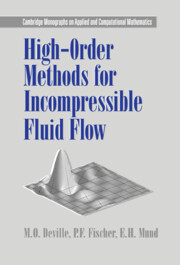Book contents
- Frontmatter
- Contents
- List of Figures
- Preface
- 1 Fluid Mechanics and Computation: An Introduction
- 2 Approximation Methods for Elliptic Problems
- 3 Parabolic and Hyperbolic Problems
- 4 Multidimensional Problems
- 5 Steady Stokes and Navier–Stokes Equations
- 6 Unsteady Stokes and Navier–Stokes Equations
- 7 Domain Decomposition
- 8 Vector and Parallel Implementations
- A Preliminary Mathematical Concepts
- B Orthogonal Polynomials and Discrete Transforms
- Bibliography
- Index
2 - Approximation Methods for Elliptic Problems
Published online by Cambridge University Press: 24 August 2009
- Frontmatter
- Contents
- List of Figures
- Preface
- 1 Fluid Mechanics and Computation: An Introduction
- 2 Approximation Methods for Elliptic Problems
- 3 Parabolic and Hyperbolic Problems
- 4 Multidimensional Problems
- 5 Steady Stokes and Navier–Stokes Equations
- 6 Unsteady Stokes and Navier–Stokes Equations
- 7 Domain Decomposition
- 8 Vector and Parallel Implementations
- A Preliminary Mathematical Concepts
- B Orthogonal Polynomials and Discrete Transforms
- Bibliography
- Index
Summary
The first chapter gave an overview of basic principles of fluid mechanics. In particular, it introduced the fundamental equations governing the motion of fluid flows. In this chapter we deal with approximation methods allowing these equations to be solved on a computer. We use a simple one-dimensional elliptic model problem in order to introduce the basic concepts. This problem will be carried throughout the chapter. Parabolic, hyperbolic, and multidimensional problems are treated in Chapters 3 and 4, respectively.
In Section 2.1 we begin with the derivation of a boundary-value problem (BVP) from a variational principle. Different types of boundary conditions are presented, with particular attention to the choice of test functions. The existence conditions for a solution are discussed within the Lax–Milgram theorem. Section 2.2 enlarges the scope to more general linear BVPs and introduces the approximation framework of Galerkin and collocation methods. In Section 2.3 we present various finite-element approximations, some of which have connections with spectral methods. Sections 2.4 and 2.5 discuss the spectral-element and the orthogonal collocation techniques, the two main forms of high-order methods studied in this book. Section 2.6 deals with the error estimation in connection with the various approximations introduced in the chapter. Section 2.7 is dedicated to some efficient solution techniques for the algebraic systems entailed by high-order methods. Finally, Section 2.8 discusses a numerical example.
In order to make the text reasonably self-contained, key mathematical notions have been gathered in two appendices.
- Type
- Chapter
- Information
- High-Order Methods for Incompressible Fluid Flow , pp. 33 - 97Publisher: Cambridge University PressPrint publication year: 2002



